Dragonfly Sex July 15, 2007
Posted by Jennifer Schlick in dragonflies, insects.trackback
One of the cool things about WordPress is that it tells you what people typed into a search engine to find your blog. Somebody out there has been typing “dragonfly eggs” for the past couple of weeks and finding me… but I’m sure they have been disappointed. Up until now, I have had posts about dragonflies and posts about eggs… Now, finally, here’s a post about dragonfly eggs.
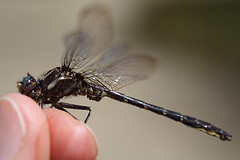 All
dragonflies have 10 segments in their abdomen. The one closest to
the thorax is called segment 1. Segment 2 on a male dragonfly is
enlarged and contains sexual organs. Segment 10 on the male also
contains sexual organs. Before finding a female, the male
transfers sperm from segment 10 to segment 2.
All
dragonflies have 10 segments in their abdomen. The one closest to
the thorax is called segment 1. Segment 2 on a male dragonfly is
enlarged and contains sexual organs. Segment 10 on the male also
contains sexual organs. Before finding a female, the male
transfers sperm from segment 10 to segment 2.
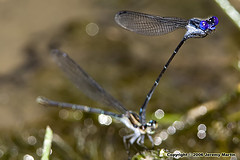 Once
a male finds a female, he will use segment 10 to clasp a her behind the
neck. When you see two dragonflies or damselflies flying like
this, it is said they are in tandem.
Once
a male finds a female, he will use segment 10 to clasp a her behind the
neck. When you see two dragonflies or damselflies flying like
this, it is said they are in tandem.
Next, the female will swing segment 10 of her abdomen up to the
male’s segment 2 to retrieve the sperm. At this point the pair is
said to be copulating and may be described as a mating wheel. On our dragonfly survey sheets, there are checkboxes for reproductive behavior. 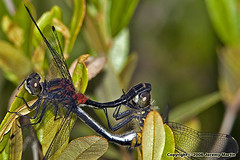 We check “tandem” for any observances of tandem flight, “copulating” for any mating wheels, and “ovipositing” when we observe egg-laying.
We check “tandem” for any observances of tandem flight, “copulating” for any mating wheels, and “ovipositing” when we observe egg-laying.
There are a few possible ways that eggs will be deposited. Some species will remain in tandem as the female oviposits. Other species may separate, but the male stays nearby guarding the female from other males. Still others simply go their merry ways…
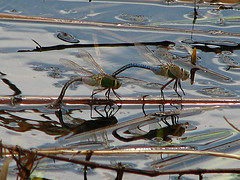 Some
females deposit eggs by tapping their tails on the surface of the
water, washing the eggs off, which then sink to the bottom of the
pond. Some land on vegetation and may even use specially designed
ovipositors to pierce the surface of plant material so they can place
their eggs inside. If you want to see a wide variety of
ovipositing methods, just go to Flickr.com and search everyone’s pictures for dragonflies ovipositing. You’ll see all possible methods!
Some
females deposit eggs by tapping their tails on the surface of the
water, washing the eggs off, which then sink to the bottom of the
pond. Some land on vegetation and may even use specially designed
ovipositors to pierce the surface of plant material so they can place
their eggs inside. If you want to see a wide variety of
ovipositing methods, just go to Flickr.com and search everyone’s pictures for dragonflies ovipositing. You’ll see all possible methods!
Finally, the eggs… When I was at my very first Dragonfly Survey training in 2005, the Common Baskettails were putting on the whole show at the pond at Rheinstrom Hill. We saw all manner of reproductive behavior. What’s really cool about this species is that after ovipositing, their eggs expand into strings that resemble minature toad egg strings. I was new to photography and only had my little Kodak Easyshare camera. Still, I was able to capture this image of dragonfly eggs – for one species, at least:
So, there you have it fellow web surfer: some dragonfly eggs. Enjoy!
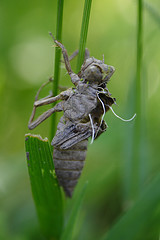 I
was pretty surprised when I first learned that dragonflies may spend as
long as 7 years on the bottom of the pond as nymphs or naiads.
When they are big enough to emerge as adults, they crawl up out of the
pond, their backs crack open, and the adult simply crawls out of the
exoskeleton of the naiad form. (Because there is no pupal stage,
this is called Incomplete Metamorphosis.) As adults, they
spend only one season eating other insects, finding a mate, and laying
eggs. Sometimes you can find the shed exoskeletons (or exuviae) in
the vegetation near ponds.
I
was pretty surprised when I first learned that dragonflies may spend as
long as 7 years on the bottom of the pond as nymphs or naiads.
When they are big enough to emerge as adults, they crawl up out of the
pond, their backs crack open, and the adult simply crawls out of the
exoskeleton of the naiad form. (Because there is no pupal stage,
this is called Incomplete Metamorphosis.) As adults, they
spend only one season eating other insects, finding a mate, and laying
eggs. Sometimes you can find the shed exoskeletons (or exuviae) in
the vegetation near ponds.
P.S. Many thanks to Flickr friends for the use of their photos for this blog posting. I hope you will all click on over to their photostreams to see their other amazing work.
Update: click here for more on dragonfly eggs.
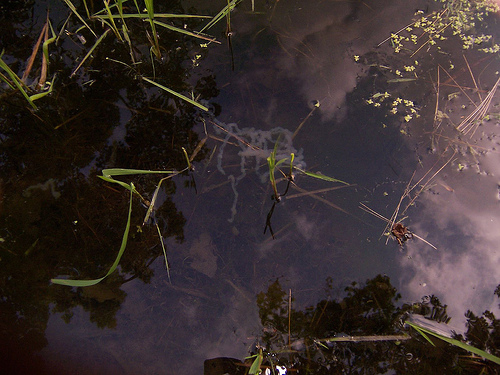


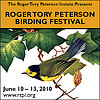



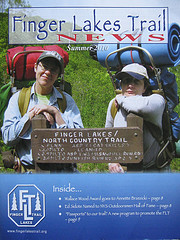


So many wonderful post talking about dragonflies and the things they do to make more dragonflies! LOL!
Wow, great info! Just last weekend I saw some tandem dragonflies and was wondering if they were mating, but since it was tail-to-head, I figured not.
PS. Tag, you’re it! (see here)
[...] « My Little Butterfly Dragonfly Eggs July 30th, 2007 Well… I wrote a couple of weeks ago about how WordPress tells you what people are typing into search engines to find your site. [...]
great information
good job, not many sites have this information, it took me hours to find.
Thank you